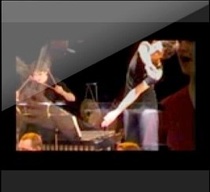OPERA DE POCHE
HERVE LEGRAND


OPERA DE POCHE
HERVE LEGRAND


1 The Daydreamings
A pocket opera
The interweaving of musical, dramatic, and choreographic composition is a hazardous business; a passionate confusion of affinities, fragrances, speeds and textures. Pivotal zones lurk in every doorway, at every frontier between two rhythms, timbres, depths and strokes. This new framework transcends them all. The music is, in a way, detached: the literary and choreographic storylines are not overpowered, but rather blossom in the intermediary layers, like petals to be plucked.
And if they contemplate their reflections with mutual admiration, in preparation, then therein lies the slow unfurling of a story.
2 The Daydreamings
A pocket opera
Paths which cross, ideas which meet and part. It is the power and the trajectory of the strokes which control the unfolding: the spreading hands, the speaking body, the talking lips.
This work is a pocket opera: the narrative and its gestures. The same liberty, the same secrets as its big brother, but lightness of line, reserve in its form and its mixtures. The work spreads out over about one hour and a quarter: forty five minutes of music for small orchestra and two instrumental voices, thirty prose texts clustered in between the musical movements, six or seven irruptions, each lasting a few minutes, a dancing form, in slow motion, to resonances ( bells, a gong, a tam-tam... ).
The voice which says and the body that speaks evolve alongside the orchestra and the singing voices. Hand in hand. The music stands are individually illuminated. A stark light traces out circuits. Like in a ball, the band leader creates and dismantles the illusions.
The characteristics are subtle but the rules are simple. A chamber orchestra, two voices, a recitalist, a dancer. Music which looks at itself, touches itself - perhaps liking a work is finding something of onesself within it.
3 Description
The Daydreamings is a classical piece, lasting about 40 minutes, for small orchestra and two voices. Its original purpose, from which today it is totally detached, was to accompany Bertolt Brecht’s great theatrical fresco, “The Days of the Commune”.
Divided into five segments, it is impregnated with operatic notions while not having the principal mechanisms of an opera: it has an inherent theatricality without being subservient to a libretto; supple, ductile, because it is not immediately constrained by the fences of a story.
This elasticity is one of the chemical properties of the musical structure, which allows the suspension of the stroke so that the action can run its course.
The staging of this score is enhanced by dance, the spoken word, lighting effects etc..., the musical text supplying the coherence, the continuity of the whole, the expressive sensibility.
Thus one arrives at a sort of musical machine: the music being the impulse, the rhythmic geography, the preamble, and the staging being the flesh on the bones, the fragility of a face upon an abstract purity.
Until now, no story, in the real sense of the word, has been attributed to the work. Dramatically speaking, it relies upon physical expression which is directly in tune with the audience, without necessarily leaning upon mutually deductable elements.
In brief, the purpose of this musical text is not to comment upon a forthcoming action but rather to open the way for it, move with it, and eventually to nestle in its folds.
5 Basic technical information
The orchestra:
2 voices(mezzo-soprano, baritone)
3 woodwind(oboe, clarinet and bassoon)
3 brass(french horn, Eb trumpet, trombone)
2 percussionists
1 harp
3 strings(viola, cello and double base)
(The orchestral material exists and the work is free of copyright).
1 dancer
1 recitalist
sound, lighting
costumes, scenery, staging
Duration: 80 minutes approx.
Current stage of the project
Score completed
Text “Poème Gitan” written, unpublished
Presentation documents
Recording of the five movements
Video cassette
Regular rehearsals aiming at possible public rehearsals
Objectives
Establish a co-production which will allow the artistic perfectioning of the project, and eventually the organisation of a tour.